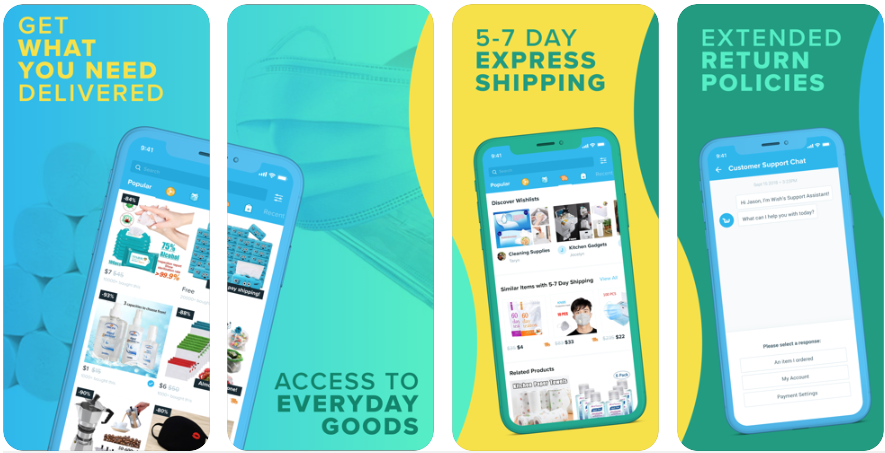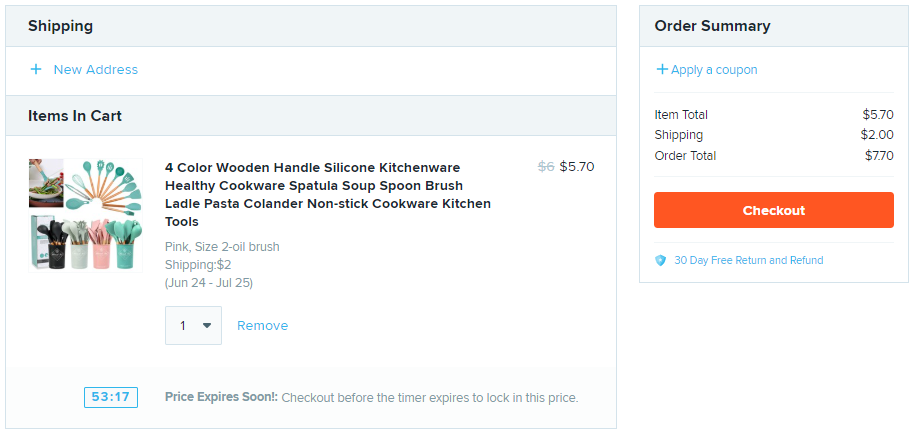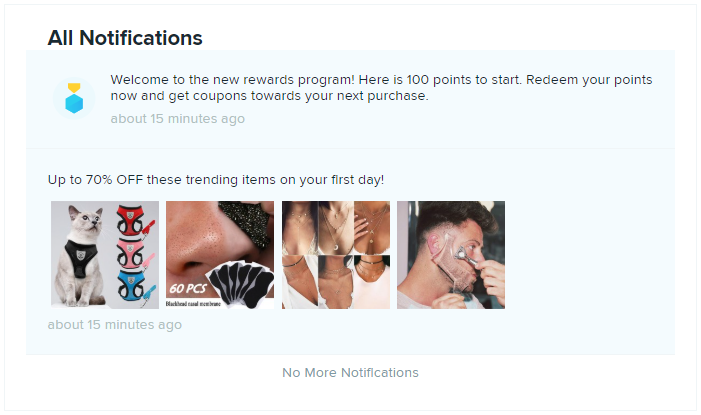How to Make a Shopping App and a Website Like Wish
Want to build a shopping app and website like Wish? In this article, you’ll find out what Wish is, why it’s so successful, and how to create a shopping website that can thrive just like Wish does.
What is Wish?

Wish is a leading online shopping platform. With 500 million users and more than one million merchants, it’s the #1 shopping app in 42 countries. The platform was founded in 2010 as an application that allowed people to create lists of things they would like to buy later. Wish used to link users to websites selling listed items so they could buy those items directly from merchants.
After some time, Wish established partnerships with merchants and gave users the opportunity to buy items directly on its platform.
To distinguish itself from other shopping platforms and apps, Wish uses steep discounts and extremely good bargains.
So, how does the wish shopping app work? Wish works with different manufacturers, brand owners, retailers, crafters, creators, and artists to offer a wide variety of items from pens to MacBook Airs. Users can sign up with Wish for free, and the platform charges no subscription or listing fees. Instead, retailers pay a percentage of each sale through the platform. Wish has a strict fulfillment policy stating that orders must be sent out within five days of the purchase date. Today we’ll talk about how to build a shopping app and a website like Wish.
Wish marketplace in numbers
Here are a few key facts about the Wish marketplace in numbers:
- 8 years on the eCommerce market
- 900 employees
- 1 million merchant partners
- 80 million visitors in the last six months
- Over 300 million items for sale
- 80% repeat purchases
- $11.2 billion valuation in 2019
How does a shopping app like Wish make money?
The Wish platform uses an online marketplace business model. This means Wish connects shoppers and merchants but it’s not involved in the transactions between them. The platform used to charge a cost-per-click commission to sellers and advertisers. But today it charges sellers 15% of the sale price of each item they sell on Wish.
Key factors in the Wish business model:
- Focus on mobile users
- Various items from different categories
- Separate apps for different product categories
- Encourages impulsive shopping
- Ridiculously low prices
The secret of the Wish business model is simple: When people buy something cheap, they can’t stop. Buyers think low prices can help them save money, and Wish stimulates them to buy more.
So to make your own mobile shopping app successful, provide users with low prices and special offers.
5 special Wish applications
Wish has five different applications with similar core functionality but that are devoted to different topics and designed to fulfill different needs for different target audiences.
This fragmentation is intentional and is aimed at helping customers find exactly what they want.
- Wish for Merchants. This app serves as an admin panel to help sellers trade successfully. The Wish for Merchants app has tools and features that make selling online fast and convenient.
- Geek Wish. This app focuses only on selling electronic devices. It offers products such as laptops, smartwatches, and tablets.
- Home Decor. This app offers a wide range of home products and accessories. It’s divided into sections like kitchen, bedroom, and bathroom.
- Cute Wish. This app is for beauty shopping. It contains makeup products, accessories, and clothing.
- Mama Shopping. This app targets mothers and mothers-to-be and provides a selection of baby products, maternity wear, toys, accessories, and baby clothes.
Main features of a shopping app like Wish
User registration

Let your users choose between three methods of registration. The first is to sign up via social media accounts like Facebook or Instagram. The second is standard registration using an email, name, and other contact details. The third is registration via phone number. Without registering, users won’t be able to see any deals or make purchases.
Shopping advice
After users register, the typical next step for a shopping app like Wish is to ask them to choose product categories they’re interested in. This allows the app to personalize the user experience and show users products they’re more likely to purchase.
Shopping cart

Wish provides users with two purchasing options. The first is to add an item to a wishlist; the second is to put it in the shopping cart. Products are stored in the shopping cart until a user decides to complete the purchase.
Payment gateway
A payment gateway is one of the most important features of any online shopping app. Provide secure payment options to both your customers and merchants, and don’t forget about order cancellation and cashback options. You can let users pay by PayPal, credit card, direct bank transfer, or cash on delivery.
Push notifications

Use push notifications to improve user engagement. Push notifications can notify users about the latest updates, new messages, price changes, and delivery statuses.
Virtual fitting rooms
Adding augmented reality technology makes the shopping experience more exciting. Virtual fitting rooms give users the opportunity to try on new clothes before making a purchase.
Reviews from real people

Product reviews are very important to gain trust among your customers. Real-life photos help users make purchasing decisions faster.
Style boards
Style boards make wishlists more presentable. Customers can create their own looks by mixing products they already own with those they want.
Social media integration
Social media integration makes relationships between buyers and sellers clearer and more transparent. According to Forbes, 40% of consumers purchase products after liking them on Facebook. Users are more likely to make a purchase if they know their friends or colleagues made a similar purchase.
How can you monetize a shopping app like Wish?
When building a website like Wish, you have to choose a monetization model. So, how does wish make money? Here are four monetization models to consider:
Freemium. This monetization model provides basic functionalities for free and charges a fee for using advanced features. Extra features can be useful but are not part of the core functionality.
Subscription plan. Offer buyers a subscription that allows them to post listings on the app or website.
Service fees. You can get revenue from each purchase by charging sellers for successful deals.
Advertising. Allow brands to promote their products and services on your marketplace for a price. You can choose one of the following ad pricing models:
- Cost per click. Charge advertisers every time a user interacts with one of their ads in your app.
- Cost per mille. Charge advertisers for every 1,000 ad impressions in your app.
- Cost per action. Charge advertisers only when users complete a target action, such as installing an app or signing up for a newsletter.
7 key tips for building a shopping app like Wish
1. You can multiply your shopping app’s reach by making special apps for niche products. This approach can help you grow your number of clients. However, make sure that these apps offer unique value to users.
2. Remember that an online marketplace should attract not only merchants but also buyers. To achieve the perfect balance, provide sellers with an equally high level of features and customer support.
3. Make payment options clear and trustworthy. People are more likely to pay using a system like PayPal than an unknown checkout system.
4. Customer support is important and should always be available to users. People are sometimes willing to sacrifice fast delivery for a low price, but you need to make sure customers get what they pay for.
5. Integrate your own reward system into your shopping app. This can be done for both customers and sellers and makes merchants compete for credibility. This way users can see if a seller is reliable so your shopping app gets a good reputation.
6. A bright design can help you attract attention, but it won’t keep clients if the delivery is bad.
7. Prevent off-platform deals. Try to come up with a system that prevents shoppers and sellers from making deals off the platform to avoid service fees.
Quick summary of tips for developing a shopping app or website like Wish
Developing a custom shopping app or website like Wish is a long and hard process. But if done correctly, your app can be successful and bring a lot of value to you as a business owner.
Key takeaways:
- Make special apps for niche products to grow your number of customers, but make sure that these apps offer unique value to users.
- Provide sellers with a high level of features and customer support on par with what you offer buyers.
- Integrate recognized payment gateways, as people are more likely to pay using a system like PayPal than an unknown checkout system.
- Create your own unique value proposition. Customer support is very important and should always be available to users. The market is full of great solutions, and you’ll need to stand out from the crowd.
If you want to create a custom shopping app like Wish but don’t know where to start, contact Mobindustry for a consultation.

